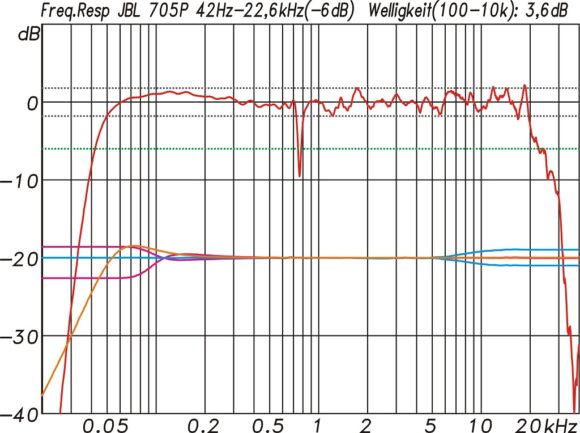Newman
Major Contributor
- Joined
- Jan 6, 2017
- Messages
- 3,565
- Likes
- 4,415
...there was a perception of more clarity and more open sound (could be placebo but I feel good saying otherwise). ...
Doesn’t everyone?
...there was a perception of more clarity and more open sound (could be placebo but I feel good saying otherwise). ...
There is a German saying that goes: "why will a dog lick his balls? - because he can"The marketing dept. has a nice point od sales etc. Similar to having 100M pixels in a phone camera (or was it 200?). Or amps with frequency response touching the long wave radio spectrum (with funny side effects sometimes). Ken Ishiwata once in the good old days of Marantz had called this "popular technology" - spot on IMHO.
OK, maybe I'm "age biased" (53.) - to hear any resonances near to 20 kHz, I would have to crank up the volume to insane levels. With normal levels, with lots of luck I will be able to hear up to 12-14 kHz, covering probably 99,9% of all music genres. Much of the pseudo-technical talk from manufacturers' marketing departments is IMHO just plain old "voodoo". Fidelity should be as high as reasonably possible, but there are many things that can be measured, but hardly heard - like little 1-2dB deviations in measured frequency response of a speaker, compared to the "mess" any real listening room will make of it. Just my 2 centsAs I'm sure you know (or I hope you do), a driver that can reasonably accurately describe a 20kHz fundamental will be a driver, that by its very nature, also must respond well above that frequency.
Now with this and the Neumann KH 310 A (wich objectively did better than the JBL) reviewed, I'd really like to see how the Genelec 8350 APM does.
OK, maybe I'm "age biased" (53.) - to hear any resonances near to 20 kHz, I would have to crank up the volume to insane levels. With normal levels, with lots of luck I will be able to hear 12-14 kHz, covering probably 99,9% of all music genres.
There are many more Hi-Fi enthusiasts than pros buying upper class studio monitors, I guess. There is a German saying that goes: "why will a dog lick his balls? - because he can"The marketing dept. has a nice point od sales etc. Similar to having 100M pixels in a phone camera (or was it 200?). Or amps with frequency response touching the long wave radio spectrum (with funny side effects sometimes). Ken Ishiwata once in the good old days of Marantz had called this "popular technology" - spot on IMHO.
Anyone got a reason as to why companies bother making drivers do anything beyond 20kHz in this sector? I get perhaps if you're using singal generators to output some odd sounds in some scientific field. But 36kHz? I don't get it.

From Focal's website :
View attachment 110078
This JBL 708P appears to be a speaker worthy of auditioning and consideration.
Note: Rating is for far-field listening.
Preference Rating
SCORE: 5.0
SCORE w/ sub: 6.8
Frequency response: +/- 4.8dB 41Hz-20kHz
View attachment 109998View attachment 109999View attachment 110000View attachment 110001View attachment 110002View attachment 110003
_______
360° polars, to analyze positioning accuracy:
Horizontal:
Vertical:
So a the mic was off center by a bit to the right and a bit too low.
Yeah, looking back at the JBL LSR308P MkII review, it's clear that JBL might be eating its own lunch with that model at an 85% discount versus the 708P. The 308P MkII has smoother in-room response and better directivity, and the only sacrifice appears to be a bit more distortion.
The crossover here is 1750Hz. If the crossover were down in the 400Hz range you'd have approximately equal power requirements for woofer and tweeter. And that's assuming you had equal sensitivities for both drivers....which you don't here. The tweeter/guide in the 708p is way more efficient than the woofer.JBL claim to have 2 channel amplification for these speakers with a 250W amplifier for the LF and a 250W amplifier for the HF. Clearly they understand the importance of having equal capability power delivery across the audible spectrum, unlike many other companies who economise on the HF amps. Not that a single tweeter compression driver voicecoil could absorb 1/4kW for long...
@amirm most interesting review! The menu/selector wheel reminds me of my Canon EOS cameras. Do they have captive nuts/mounts on the bottom for standmounting BTW?
I sent Amir the Genelec 8050b for review, so we'll be able to compare them in the near future. MSRP these Genelec speakers are similarly priced especially if you get demo models. I prefer Genelecs due to their extreme build quality compared to the JBLs.This or genelecs?
Without a doubt one of the best speakers you can choose for maximizing home cinema effects
The crossover here is 1750Hz. If the crossover were down in the 400Hz range you'd have approximately equal power requirements for woofer and tweeter.
